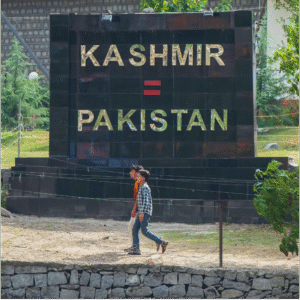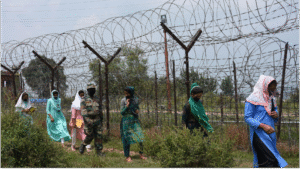16-year-old Arnav Maheshwari examines how the 2025 attack and history continue to shape Kashmir today

Sign by the Neelam River, which marks the Line of Control in Pakistan-administered Kashmir.
Picture by: ZUMA Press, Inc. | Alamy
Article link copied.
July 17, 2025
The Pahalgam terrorist attack and the ongoing conflict in Kashmir

On 22 April, one of the deadliest terrorist attacks on civilians in India in over a decade took place in southern Kashmir, in the Baisaran Valley near the popular resort town of Pahalgam. Five gunmen opened fire on a group of tourists visiting the hill station, killing 26 men and injuring at least a dozen others.
According to survivor accounts and officials, the terrorists systematically segregated the victims based on religion, killing Hindus and sparing Muslims. Most of those killed were Hindu tourists from India. A Christian tourist was also shot dead. The attack shocked India and drew condemnation from across the world.
Indian security agencies identified the attackers as members of the Resistance Front. The group is linked to the Pakistan-based Lashkar-e-Taiba, which has been designated a terrorist organisation by the UN.
Harbingers’ Weekly Brief
Most of Kashmir is divided into two parts, one (55% by area) controlled by India, the other (30%) by Pakistan, with both countries claiming the whole region. China controls a smaller area. The murders were part of a long-standing pattern of cross-border terrorism that has fuelled violence and instability in Kashmir for decades.
Tensions over Kashmir are intensified by the fact that both India and Pakistan are nuclear powers, with India holding about 180 warheads and Pakistan 170. India follows a no-first-use policy, while Pakistan does not – adding volatility to an already unstable part of the world.
This Q&A explains what happened in Pahalgam, how it is relevant to the larger conflict over Kashmir, and why it matters today.
What is the Kashmir conflict?
The conflict, shaped by religion, nationalism and history, centres on Kashmir, which lies in the far northwest of the Indian subcontinent and holds a Muslim majority. Kashmir has been a source of tension since 1947, when British-controlled India was partitioned into the independent nations of India and Pakistan.
The region is currently divided into two distinct territories – the Indian-administered states of Jammu and Kashmir, and Ladakh, and the Pakistani-administered Azad Kashmir and Gilgit-Baltistan – separated by the 740-kilometre Line of Control. The LoC, established in 1971, is one of the most heavily militarised borders in the world.
There have been numerous clashes across the border since the 1970s. These took a more violent form in the late 1980s when militant groups became involved in an armed insurgency.
These groups have destabilised the area, turning a territorial conflict into a broader security issue that remains unresolved four decades later.
These groups have long operated from across the border, using launchpads near military installations, receiving intelligence and logistical support from handlers based in Pakistan, and securing advanced weapons such as American-built assault rifles, such as those used in the 2025 Pahalgam attack.
Terrorism has prolonged the Kashmir conflict and blocked peace. Groups based in Pakistan, such as Lashkar-e-Taiba and Jaish-e-Mohammed, have carried out cross-border attacks that have killed large numbers of civilians and security personnel in India.
Major incidents include the 2008 Mumbai attacks, which took 165 lives, the 2016 Uri attack that killed 19 Indian soldiers, and the 2019 Pulwama bombing that claimed another 40 lives. The continuing threat of terrorism keeps the region unstable and undermines diplomacy and bilateral relations between India and Pakistan.

Students walk past the Line of Control in Poonch in India-administered Kashmir.
Picture by: ZUMA Press, Inc. | Alamy
How did India respond to the Pahalgam attack?
The country acted swiftly after the Pahalgam attack, reflecting its security doctrine that “terror and talks cannot go together”. India’s prime minister Narendra Modi declared, “India will identify, track and punish every terrorist and their backers. We will pursue them to the ends of the Earth.”
On 7 May, Indian forces launched what it called Operation Sindoor: precision strikes on nine terrorist sites in Pakistan and Pakistan-administered Kashmir. According to Indian officials, the strikes focused only on terror camps, avoiding Pakistani military infrastructure to curtail further escalation.
How did Pakistan respond?
Pakistan condemned the Pahalgam attack, and distanced itself from the perpetrators. In response to India’s attack on nine terror sites, Pakistan suspendedall bilateral trade valuedat $1.2bn and closed its airspace to Indian aircraft after what Pakistan’s prime minister Shehbaz Sharif called“a blatant act of war”.
Pakistan’s defence ministry reiterated that its military actions were taken in self-defence as it launchedretaliatory drone and missile strikes at Indian military positions in Jammu and fired heavy artillery along the Line of Control.
Is peace possible?
Lasting peace in Kashmir depends on strengthening bilateral relations, ensuring accountability, and expanding economic opportunity for all.
Both sides have invested in development, with Pakistan making efforts to improve infrastructure and public services in Azad Kashmir. Yet poverty and shortages remain more severe than in Indian Kashmir, fuelling censorship and protests over basic needs. In an attempt to promote stability, India has prioritised major projects in Jammu and Kashmir, including highways, rail links and tourism, though progress remains uneven.
The future of the conflict may well depend on the youth in both countries. A Lahore-based survey shows that 95% of Indian and 93% of Pakistani youth believe peace is essential. A large majority also think that youth are “capable of changing the hate narrative” and that social media has an important role to play in building peace.
Written by:

Economics Section Editor 2025
Georgia, United States
Born in 2009, Arnav studies in Metro Atlanta in the United States. He is passionate about economics, investing, and finance, with plans to study economics at university.
Arnav joined Harbingers’ Magazine in October 2024 as a winner of The Harbinger Prize 2024 in the Economics category, earning a place in the Essential Journalism Course. During this time, while writing about the global economy, entrepreneurship, and macroeconomics, he demonstrated outstanding writing skills and dedication to the programme. His commitment earned him the position of Economics Section Editor in March 2025.
In his free time, Arnav holds leadership roles in finance-focused organisations at state and national levels and is the founder of a SaaS startup. He hopes to use his writing and leadership skills to contribute to social entrepreneurial efforts.
Arnav speaks English and Hindi fluently, with working proficiency in Spanish.
Edited by:

🌍 Join the World's Youngest Newsroom—Create a Free Account
Sign up to save your favourite articles, get personalised recommendations, and stay informed about stories that Gen Z worldwide actually care about. Plus, subscribe to our newsletter for the latest stories delivered straight to your inbox. 📲
© 2025 The Oxford School for the Future of Journalism


